Telnet to My Heart
Author: Mary Kidd
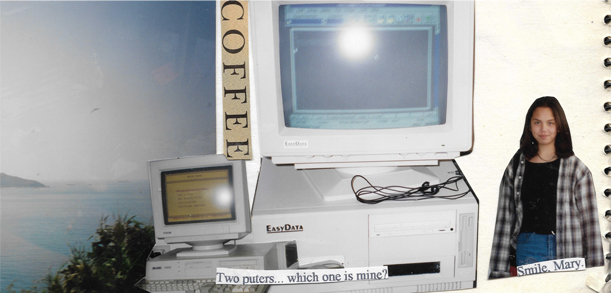
In middle school I used to make collages, many of which featured my beloved 486 PC “puter” that for many years served as the portal into my forays into Telnet chat in the early- to mid-1990s.
It was 1992 when I, at the tender age of 9, walked into my family’s home office and caught my older brother salivating over a pair of 4-color pixelated breasts on the computer. He hastily escaped the screen and proclaimed innocence, but I knew what I saw. In searching for and successfully finding my brother’s porn collection tucked away in hidden folders, I taught myself how to use the command line. This set the precedent for how I would teach myself to use computers, first to hack into my brother’s private stashes, and later, to find love on the internet. At around this time, my brother taught me how to use the DOS command prompt and a 14.4 kbit/s modem to dial into a Bulletin Board System (BBS). BBSs were insular: users could interact with one another but not in an immediate, back-and-forth sort of way, like a real-life conversation. Instead, you could download zipped grab bags full of junk, like cracked games or other warez left behind by users during their previous sessions, which is probably where my brother picked up ZIP files filled with grainy softcore porn GIFs. Learning the protocol to dial into a server and browse around piles of other people’s crap was a good introduction for me to the concept of shared digital spaces.
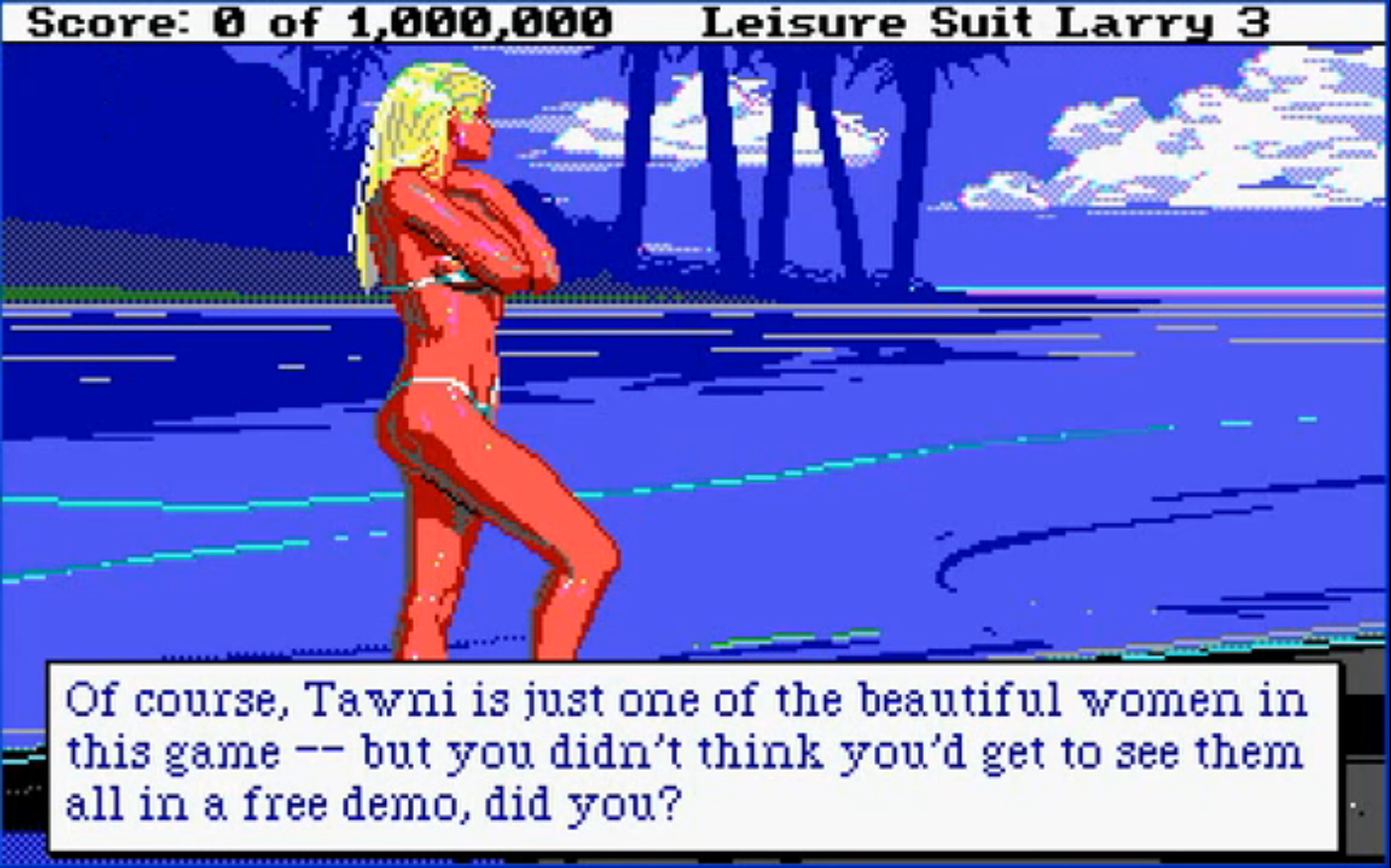
This is a screencap of Leisure Suit Larry 3 (“Passionate Patti in Pursuit of the Pulsating Pectorals”). This image is not far (in terms of image quality and cheesiness) from what I witnessed up on my brother’s computer screen that fateful day in 1992.
A few years later in 1995, my brother became a system operator, or SysOp, of his high school’s BBS. It was at this time that he learned about and showed me how to use the Telnet (a combination of the words TErminaL and NETwork) Client to log onto “talker” servers hosted out what I assume were an assortment of college dorm rooms and carpeted dens, that allowed many users at a time to employ the command line interface to chat in real time. The first chat space I ever logged into was the Telecafe, and from there I got recommendations from other users for addresses to other spaces. It’s hard to say how many servers were around at that time (probably hundreds or maybe even thousands). Each talker had its own theme, kind of like Geocities neighborhoods, and within them had flourishing communities of users.
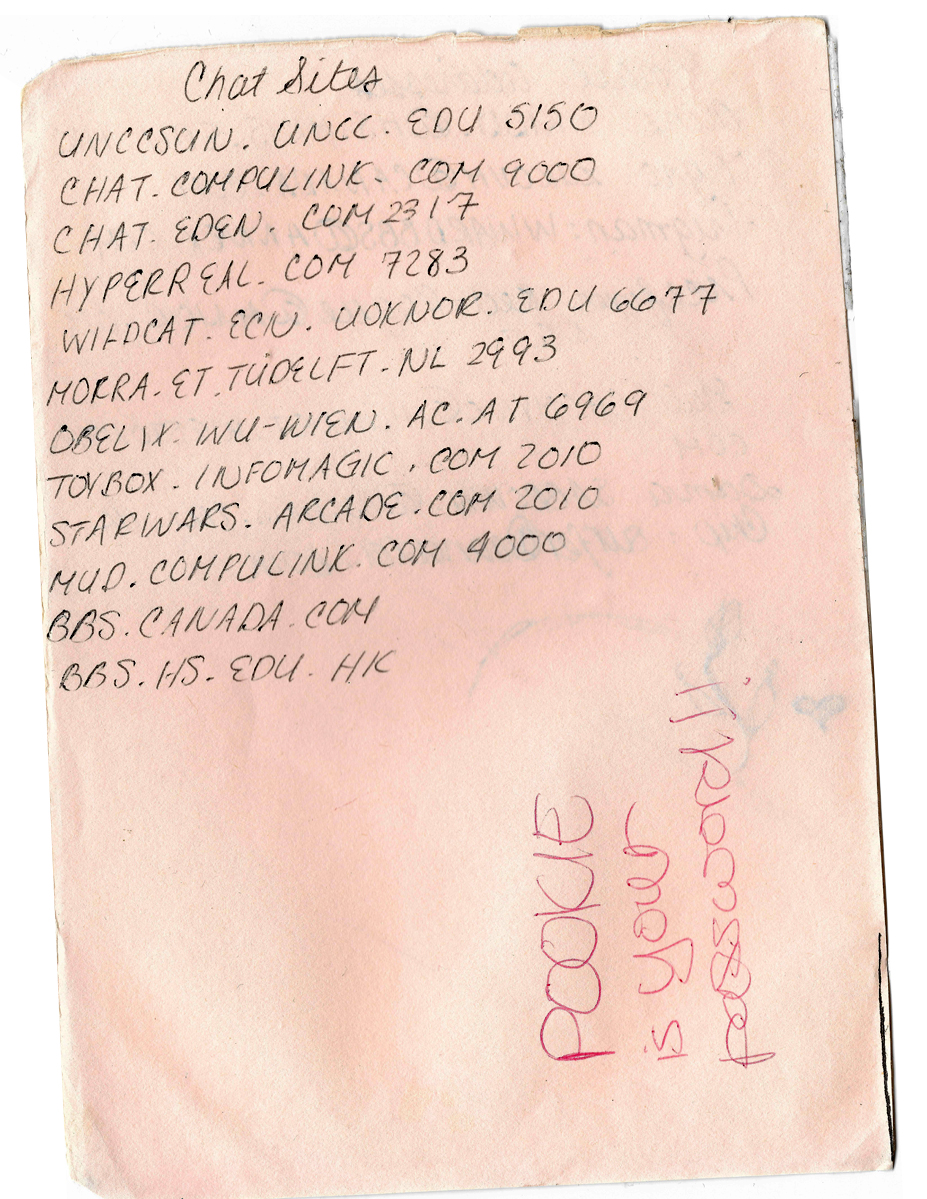
A scan of a page of my middle school diary, showing addresses for some of the talkers I used to connect to in the early 1990s.
Before I ever logged into a chatroom, I remember playing a game on the computer called ELIZA, a program that emulated a psychotherapy session led by the user or “patient”, who would type questions into a prompt. ELIZA would answer back, giving the impression of interaction. At first, I was thrilled that I was able to carry on a seemingly normal conversation with ELIZA. However, after posing a few farther-reaching questions the fun was soon over: I started to notice repetitive syntax, and realized that ELIZA was about as alive as a traffic signal light.
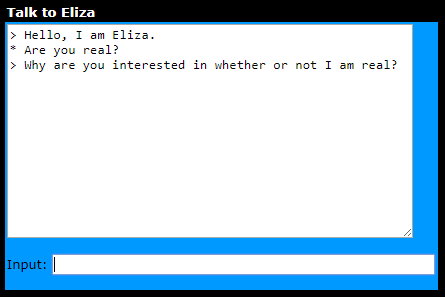
Engaging ELIZA is hard.
I have a very distinct and vivid memory of the exact moment I realized that I was engaging in real-time conversation with someone I had never met before by typing in sentences into the prompt and pressing enter. I kept typing in, “Is this real?” over and over again, expecting to eventually meet the cold, dead face of an ELIZA-like bot. When I was finally convinced that the conversation was, in fact, really real, I experienced a total body and mind epiphany. I was a shy, awkward and anxious pre-teen who was being offered an alternative method to engage with strangers in a non-frightening way and on my own terms. The sentences I typed into the prompt could be reworded, or entirely deleted, and their delivery could be as slow as I wanted: the closest equivalent to an awkward pause could be explained away by server lag. If the conversation didn’t strike me as particularly interesting, I could move into another room or log into another server. In addition to this, people were actually approaching me to talk: cyberspace had no benches for wallflowers to sit on. The way I imagined cyberspace in my mind, was that each logged in user was a floating orb hovering over a Cartesian plane situated in space, talking to each other in gentle voices, and non-threateningly popping in and out of existence.

The login screen for The ‘Burbs, a talker that is surprisingly still up and running 20 years later.
In addition to being offered a better communication tool, I had inadvertently discovered a perfect haven for my pre-teen-charging-full-speed-ahead-into-that-nasty-spike-filled-place-called puberty-self. I could slip into a sort of Neuromancer “jacked in” state: my body would dissolve, and I would become “marie” and later, “evergreen”, absolved of my own corporeality, queen of my own universe. During the day, while my more socially adjusted friends were asked out on dances and dates, I got fast-tracked into the dark world of cyber-romance and love, whose bounds were limited only by my own imagination, instead of dance tickets. Chatrooms were not without their dangers: I was floating around in a sea of mostly male perverts and predators. I remember a 30ish-year-old Chicago-based CPA with the handle Pricefixer, who upon discovering that I was a 11-year-old girl, nicknamed me “cherry”, and when noticing I had logged into a room, would private message greet me cherry-shaped emoticons: @– @–. I remember another user questioned me about whether or not I wore stockings and if I liked the feeling of the fine mesh rubbing against the soles of my feet. This sort of behavior, even within the confines of a chatroom fantasy, was definitely wrong. However, when I was confronted with a horny gross dude’s proddings and advances, the physical distance the internet placed between my body and theirs, coupled with my ability to be able to poof out of existence simply by typing in an exit command, allowed me to encounter otherwise terrifying, violating situations with an air of indifference or even amusement.
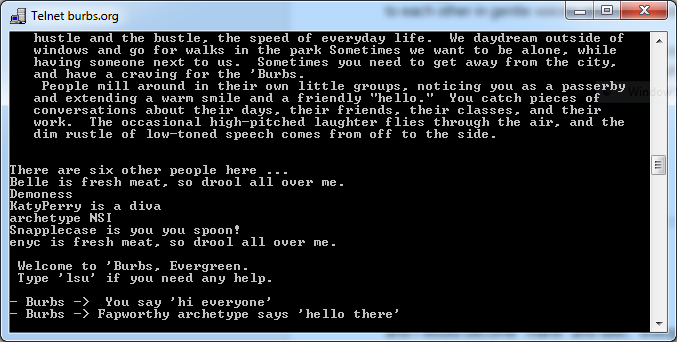
An example of what text-based chat looked like.
It’s important to note that, early on, talkers did not require user registration: you could connect at any time and choose any name you wanted, so identities were never fixed. In addition to this, my initial chat experiences occurred before scanning and digital photo technology were readily available: all interactions were entirely text-based, and any picture exchanges happened over “snail” mail. Behind several cloaks of anonymity, I remember feeling no fear interacting with horny older men: in hindsight, the scariest part about it all is realizing how many hundreds of attempts were made to exploit my perceived innocence. Today, of course, the chat experience is a lot different, and the ability for stalkers and predators to harvest personal information is all too easy. I’m grateful for having to have experienced early internet chat for the privacy it afforded me during my most vulnerable years.

This was the first photo I ever digitized in 1997, when my middle school library purchased a scanner.
And somehow, through the pedophilic muck, I managed to find and connect with people my age. They were similar to me socially (outcasts, freaks, nerds), trying to survive their middle and high school existences, and using chat rooms as a mental health respite. My first cyber boyfriend went by the handle Pyro. I have no memory of how our relationship blossomed. He was the first person I ever fell in love with, which I excitedly proclaimed to him using the “whisper” command. “Whispers” allowed users to deliver private messages to one another, and it was through things like whispers, and later, expanded talker functionality that allowed users to create private, invitation-only rooms, that cyber couples like myself and Pyro used to weave into our very own fantastical cyber-relationship hive. Along with whispers (which were especially charged when delivered in a private room, giving the impression of pillow talk in a bedroom), our online interactions consisted of repeated use of “emotes”, another command that enabled the user to frame their username in the third person performing a pre-defined action. So, if I typed
\> emote smooch pyro
The command prompt would output:
\> Evergreen gives Pyro a warm, affectionate kiss!
It’s hard to imagine love built upon a scaffolding of canned emotions, but, for a couple of very young people who could barely make small talk in real life, these commands were helpful for articulating otherwise very deep and complex feelings.

A collage I made showing the view out my apartment window in Hong Kong, showing what I likely saw as I sat alone in a private chat room, awaiting my Canadian cyber boyfriend to come home and log in.
When I met Pyro, my family was living in Hong Kong, so we scheduled our chats around our 12-hour time difference. I would stay up late into the night, waiting for him to return home from school or errands, and we would chat until his mom or dad would kick him off the phone line. When my school year ended and I was free of the constraint of a bedtime, our chats would last well into my early morning hours. While watching the sun rising over the South China Sea, I schemed up ways with him to meet each other in-person.

A handwritten letter from my first internet boyfriend dated July 1995 (I was 11 years old). Phone calls between Hong Kong and Canada were expensive and rare, so this letter contains instructions for me to leave a message in his mailbox while visiting my brother, who lived in Oregon at the time, so he could hear my voice.
A few months into our relationship, I received a handwritten letter from Mike, the human boy behind Pyro. Painstakingly written on a single page of college-ruled notebook paper in blue ink, it was mailed along with a photo of him in a suit and tie, standing in front of a brick fireplace in a modest middle class living room. I remember the disappointment I felt seeing his face for the first time, not because I thought he was unattractive, but because it fundamentally disrupted my pristine, mental characterization of him. The shaky handwriting and stifled voice of the the letter’s author appeared and sounded nothing like Pyro of the Chatroom’s swiftly-delivered emotes. I quietly tucked away Mike’s photo and letter, and continued to perpetuate the fantasy of my bodyless cyber boyfriend for another year.

Tokens of my first internet face-to-face meetup: the belly chain I wore, a Canadian “toonie” dated 1996, and a heart-shaped promise ring. The Zippo lighter, which I got personally inscribed for him, was never mailed: we broke up a year later.
We met, finally, in 1996: I was visiting my best friend at the time who lived in Buffalo, and Mike convinced his parents to drive him the 2 hours over the Canada/US border to meet me in a mall food court. I remember the outfit I wore included a belly chain, a necklace with the word “peace” written in pink enamel, a yellow babydoll t-shirt, flared jeans, and borrowed Birkenstocks. I remember the gut-gripping, sweat-inducing nervousness leading up to the point at which the Pyro I knew disintegrated, forever, and from his ashes emerged Mike, a tall, gangly, soft-spoken Canadian guy slouching shyly next to his mother. I remember he reeked of Calvin Klein “Escape” cologne (the irony of this is not lost on me). The smell of this to this day can literally knock me off my feet into a nostalgic coma.
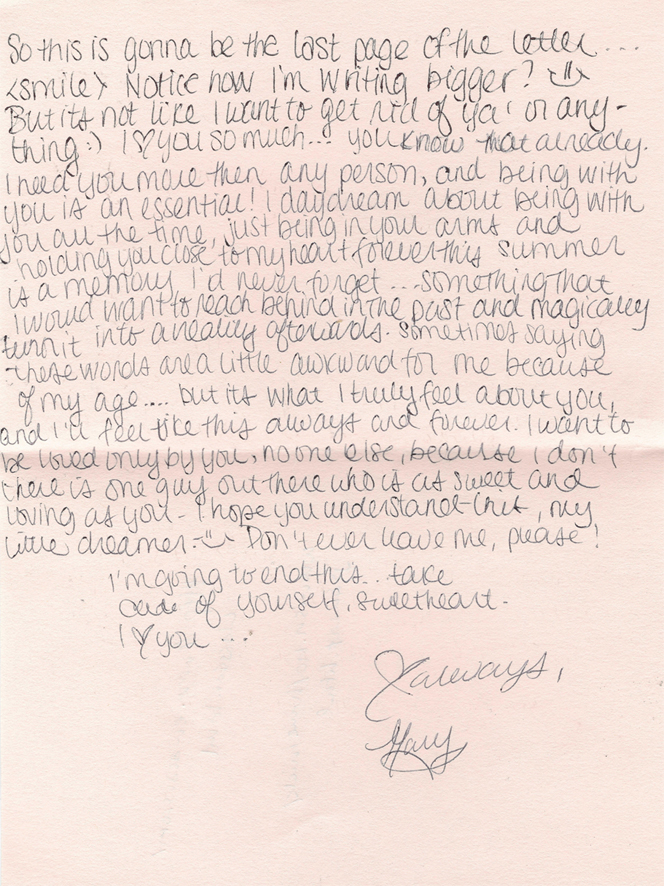
An unsent letter to Mike dated 1996, filled with declarations of eternal love and devotion.
Although Mike was a perfectly sweet, polite, and respectful person, I will always consider Pyro as the person-entity I truly fell in love with. Through the medium of the chatroom, I was given the gift of being able to temporarily drown out the voice of my constant self-loathing with the warm drone of compliments and reassurances from my cyber boyfriend, who told me that I was worth thinking about, seeing, and knowing. On a bench in front of a Sears department store, Mike placed a promise ring in the shape of a heart onto my finger. I still keep this, and a few other tokens from around this time, reminding me how the early internet afforded me not only an important and necessary protective space, but later drew a bridge for me to cross into the other side of my vulnerability, and into my first IRL smooch.